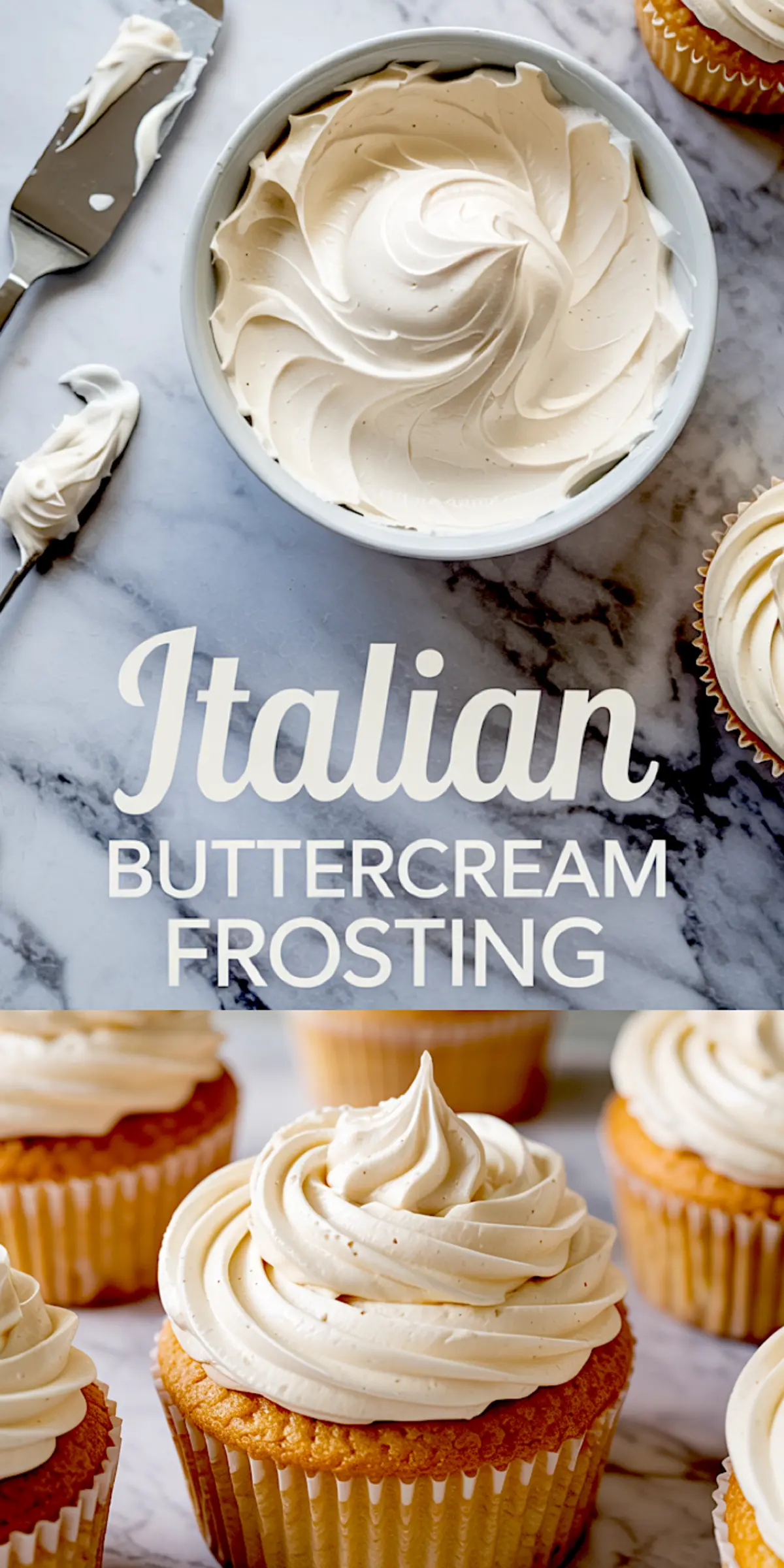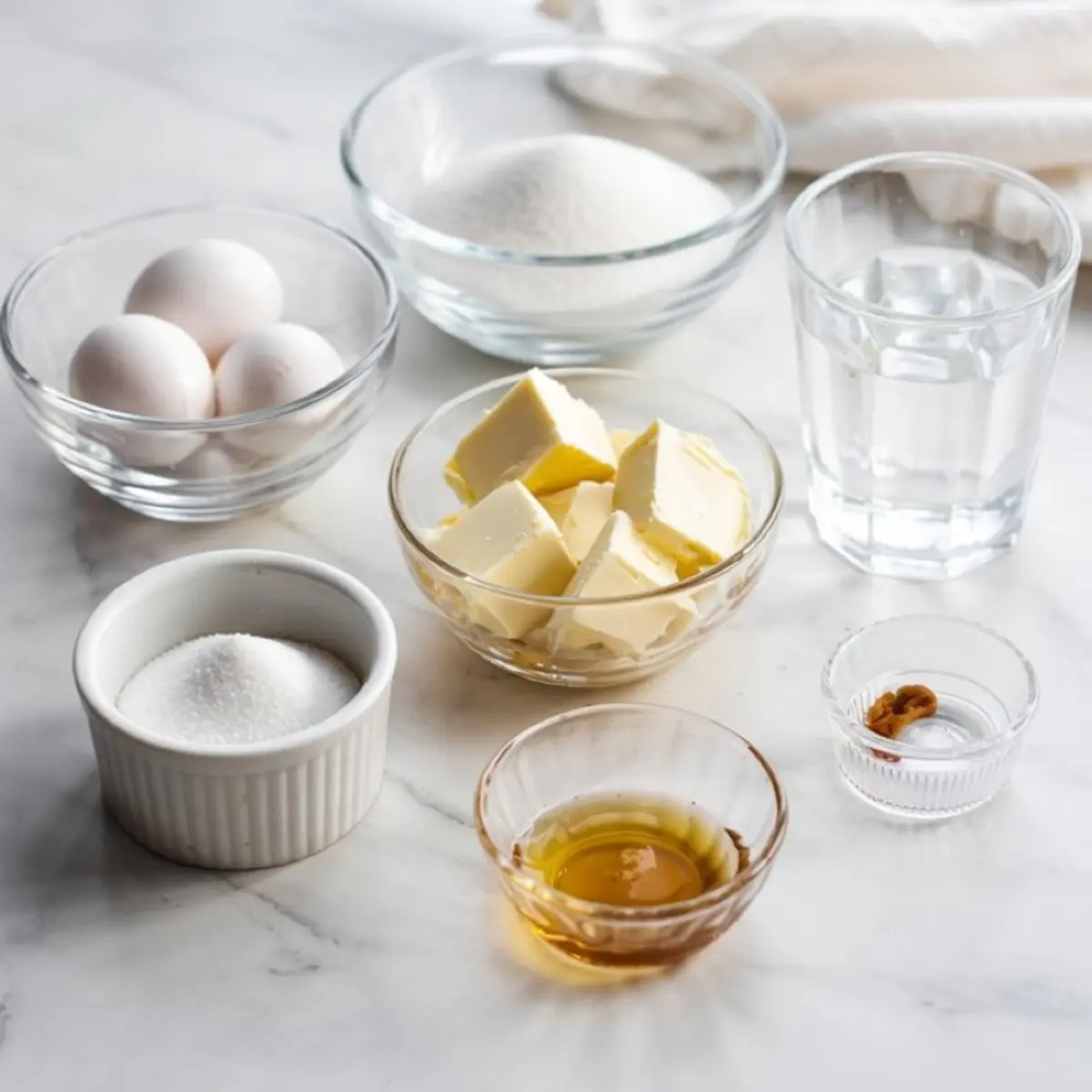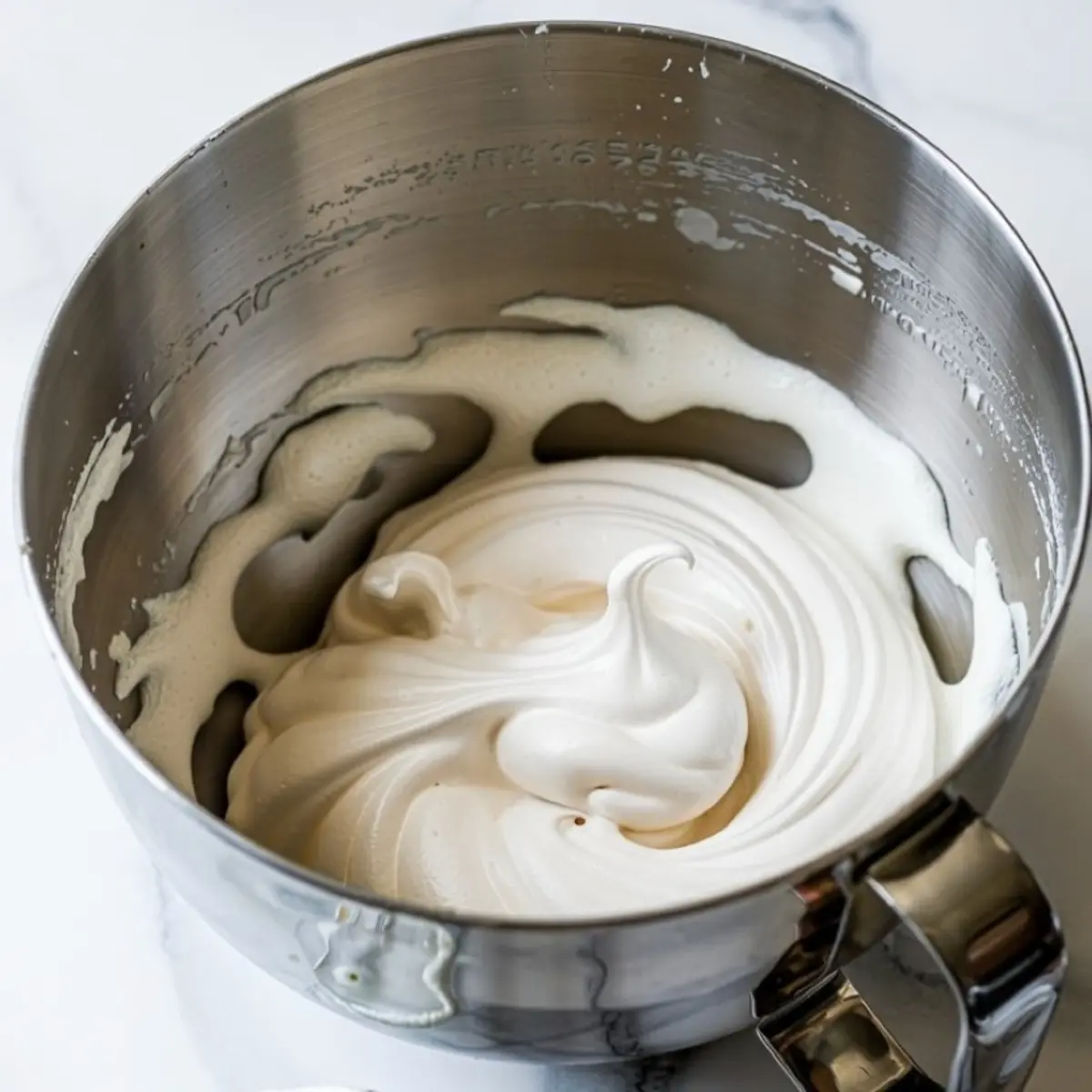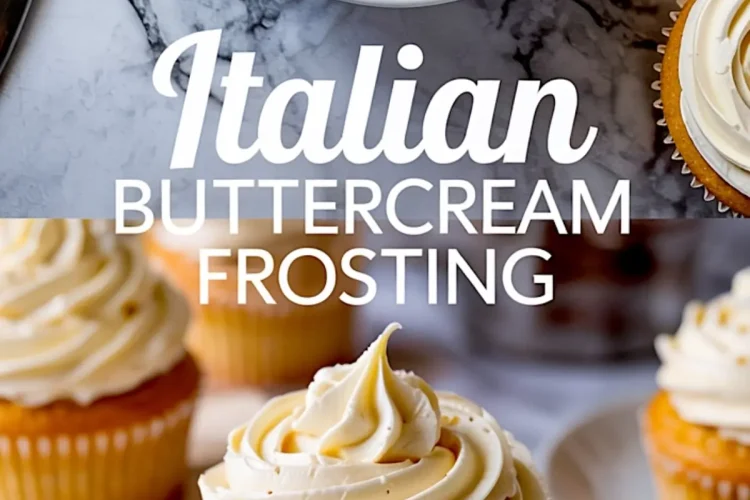This Italian buttercream frosting recipe starts with egg whites and finishes with a smooth, pipeable finish that holds firm and tastes clean. You’ll learn exactly how to handle hot sugar syrup, manage soft peaks, and fix common texture issues. I’ve tested this many times on layer cakes and cupcakes, and it’s the one I return to for special orders.
This frosting relies on Italian meringue as the base. It isn’t just whipped cream or sugar-heavy buttercream. It gives you structure without sacrificing flavor. If you’ve tried American buttercream and found it too sweet or grainy, this will feel like a different experience. The flavor stays balanced, and the consistency works for piping roses or smoothing clean edges.
I use this when I want precision, especially when decorating wedding cakes or celebration cakes that need clean structure.

Italian Meringue Makes a Difference
Italian buttercream frosting starts with hot sugar syrup poured into whipped egg whites. This technique gives stability and silkiness. The method takes practice, but it pays off. You control the sweetness, and the meringue base makes it less greasy than other buttercream recipes.
You won’t need powdered sugar. This sets it apart from simpler options like this vanilla buttercream frosting, which uses confectioners’ sugar for structure. Italian buttercream behaves differently, with a finish closer to mousse than frosting.
You’ll taste the difference. And once you understand the sugar syrup step, the rest feels straightforward.
Ingredients That Shape the Outcome

Room temperature egg whites are essential. Cold whites won’t whip evenly, and any trace of yolk or grease can ruin the meringue. I always separate eggs in a small bowl, one at a time, just to be safe.
Cream of tartar or lemon juice helps stabilize the whites. I’ve tested both. Lemon juice adds a hint of brightness, but cream of tartar gives a slightly tighter structure. When I need sharper detail in piping, I go with the cream of tartar.
The butter should be soft but not greasy. If it’s too cold, it clumps. Too warm, and it breaks the emulsion. I cut it into tablespoons and let it sit while I make the meringue. That timing usually works out well.

The Hot Sugar Syrup Step is the Heart of the Recipe
This part makes the difference between soft meringue and something that can hold a cake’s shape for hours. Combine sugar and water in a saucepan. Stir just until dissolved, then leave it alone. Once it starts boiling, resist the urge to touch it.
Use a candy thermometer and pull it at exactly 240°F. Overcooking will harden the syrup. Undercooking leaves the meringue soft and unstable.
While the syrup heats, beat the egg whites. They should hit soft peaks just as the syrup reaches temperature. This timing matters. If the whites are overbeaten before the syrup is ready, they lose elasticity. If they’re underbeaten, the syrup won’t incorporate well.
Adding the Syrup Without Deflating the Meringue
With the mixer running on medium, pour the syrup in a thin stream. Aim between the whisk and the side of the bowl. Don’t pour directly on the whisk. That splatters syrup everywhere and hardens on contact.
Once all the syrup is in, increase the speed to high. Whip until the bowl feels completely cool. That can take 10 to 15 minutes. This step is non-negotiable. If the bowl is warm, the butter will melt, and the frosting won’t hold.
This base should look glossy and form stiff peaks before moving on.
Butter Choices and Texture Comparison
In my notes, I’ve tested both salted and unsalted butter here. Salted adds depth, but I found it muddied the clean finish of the vanilla. Unsalted butter gives you better control, especially if you’re planning to flavor the frosting.
Switch to the paddle attachment once the meringue is ready. Add butter slowly, one tablespoon at a time. The frosting may look broken or curdled. Keep mixing. It will pull together into a smooth, silky cream.
If the texture seems loose, chill the bowl briefly. Then beat it again. This usually brings it back.
Vanilla Adds Warmth and Finishes the Flavor
Use real vanilla extract here. I’ve used both clear vanilla and regular. The clear kind works for bright white cakes, but I prefer the flavor of pure extract. It rounds out the butter and meringue without overpowering the balance.
If you like experimenting, this frosting also takes citrus zest or almond extract well. Just be careful not to overwhelm the clean base.
You can use this frosting on layer cakes, cupcakes, even as a filling between cookies. If you’re looking for a lighter texture, compare this to cool whip cream cheese frosting, which spreads more easily but doesn’t hold detail as well.
Serving and Storing Notes for Italian Buttercream
Once made, this frosting can sit at room temperature for a few hours. I use it immediately when possible. If you need to store it, cover it tightly and refrigerate for up to a week.
Before using again, let it come fully to room temperature. Then beat it briefly to restore the texture. It won’t spread properly while cold.
For freezing, wrap it in plastic and then foil. Thaw it overnight in the fridge, then follow the same re-whipping method.
This holds well on cakes in warmer kitchens, which makes it more stable than whipped cream frosting.
Troubleshooting Notes from My Own Kitchen
If it looks too loose, the butter may have been added too soon. Cool the bowl and beat again. If it still separates, you may need to start fresh. It happens. I’ve had batches fail when my kitchen was too warm or the syrup was rushed.
Always check your thermometer. Mine once read ten degrees lower than it should. That ruined three tries before I figured it out.
Every cake I’ve frosted with this has received compliments. It doesn’t crust like American buttercream, but it slices clean and stays silky. My clients always ask what makes it different.
If you’ve never made an Italian frosting before, this one is a reliable place to begin. It’s an ermine frosting alternative that gives cleaner structure.
Pin and Share Your Results

Save this recipe to your Pinterest board so you can come back to it whenever you need a reliable buttercream for detailed piping or smooth finishes. And if you try this frosting, leave a comment. Let me know how it turned out for you or if you ran into any questions.
Your feedback helps others and keeps the baking conversation going.
Italian Buttercream Frosting

Italian buttercream frosting starts with Italian meringue hot sugar syrup whipped into egg whites then gets blended with butter until silky and smooth. I use it when I want a frosting that holds its shape but isn’t too sweet. This Italian buttercream frosting recipe works for layer cakes, cupcakes, or anything that needs clean edges and a balanced flavor. It takes a little more effort than your average icing recipe, but the texture is worth it. I’ve used this as both a cake frosting recipe and a filling. If you’re looking for an easy Italian buttercream frosting that actually behaves when piped, this one’s reliable. Add it to your frosting recipes easy list when you want an Italian frosting that looks polished.
Ingredients
- 4 large egg whites, room temperature
- 1 cup (200 g) granulated sugar
- 1/4 cup (60 ml) water
- 1/4 teaspoon cream of tartar or 1/2 teaspoon lemon juice
- 1 1/2 cups (340 g) unsalted butter, room temperature, cut into tablespoons
- 1 1/2 teaspoons pure vanilla extract
Instructions
- MAKE THE SUGAR SYRUP: In a small saucepan, combine the sugar and water over medium-high heat. Stir gently just until the sugar dissolves, then stop stirring. Attach a candy thermometer and let the syrup cook undisturbed until it reaches 240°F (115°C). Watch closely to avoid overheating.
- WHIP THE EGG WHITES: While the syrup heats, place the egg whites and cream of tartar (or lemon juice) in the bowl of a stand mixer fitted with the whisk attachment. Beat on medium-high speed until soft peaks form. Aim to reach soft peaks at the same time the sugar syrup reaches its target temperature.
- ADD THE HOT SYRUP: With the mixer running on medium speed, carefully pour the hot sugar syrup into the egg whites in a thin, steady stream, aiming between the side of the bowl and the whisk to prevent splattering. Once all the syrup is added, increase the speed to high.
- COOL THE MERINGUE: Continue whipping on high speed until the meringue becomes glossy, forms stiff peaks, and the mixing bowl feels completely cool to the touch. This takes 10 to 15 minutes. Do not add butter while the bowl is still warm.
- ADD THE BUTTER: Switch to the paddle attachment. With the mixer on medium speed, add the butter one tablespoon at a time. At first, the mixture may deflate or look curdled—continue mixing until it becomes smooth and cohesive.
- FINISH WITH VANILLA: Add the vanilla extract and beat until fully incorporated. The frosting should be smooth, creamy, and ready for piping or spreading.
Notes
If the frosting appears too soft after adding all the butter, place the bowl in the fridge for 10–15 minutes, then beat again. Make sure all equipment is clean and free of fat or yolk to help the egg whites whip properly.
Nutrition Information
Yield
1Serving Size
1Amount Per Serving Calories 258Total Fat 17gSaturated Fat 11gTrans Fat 1gUnsaturated Fat 5gCholesterol 46mgSodium 358mgCarbohydrates 7gFiber 0gSugar 6gProtein 15g

